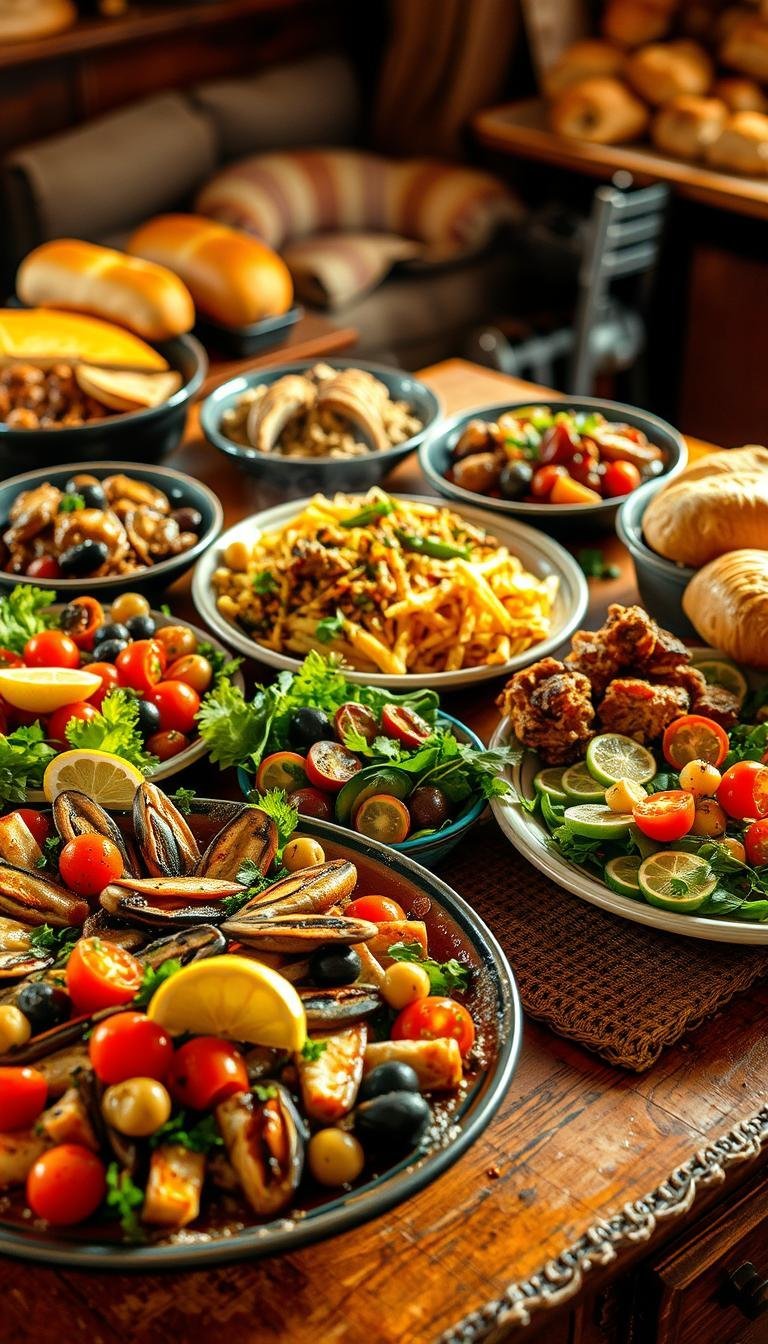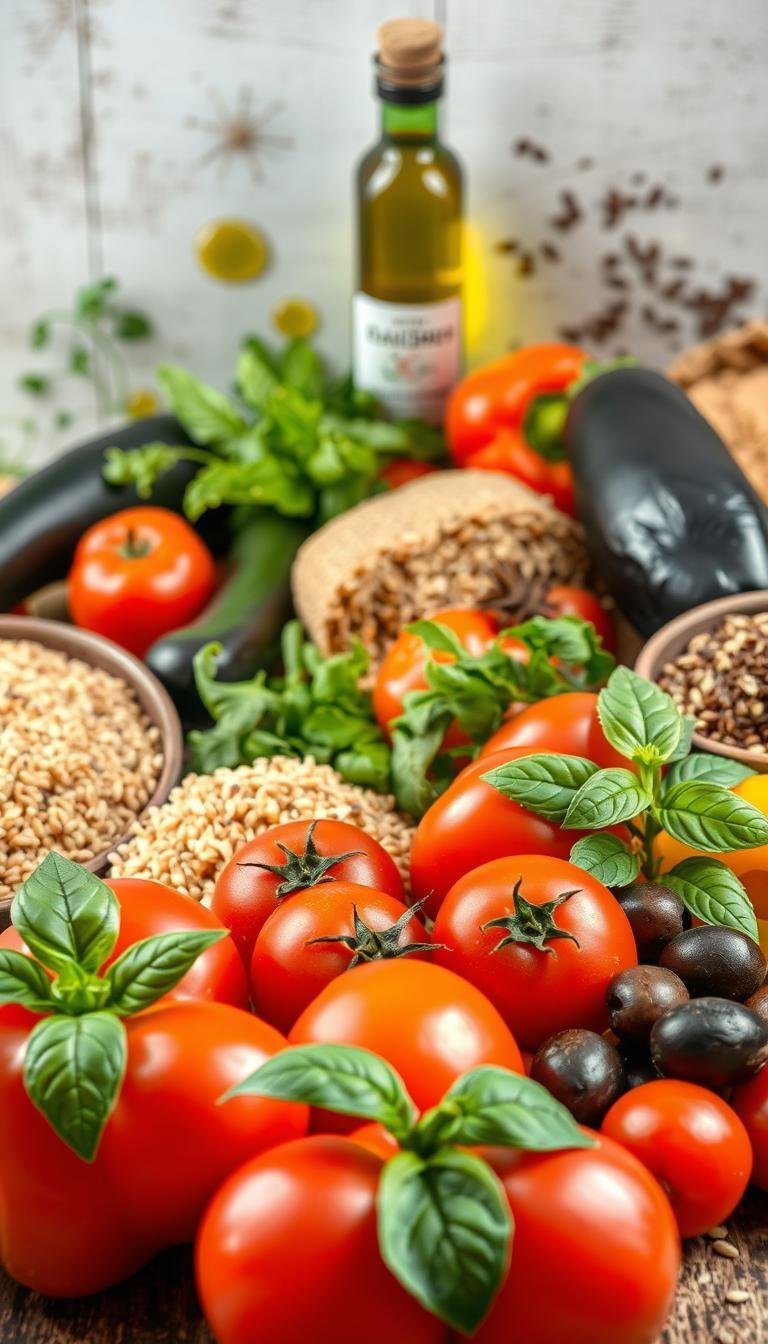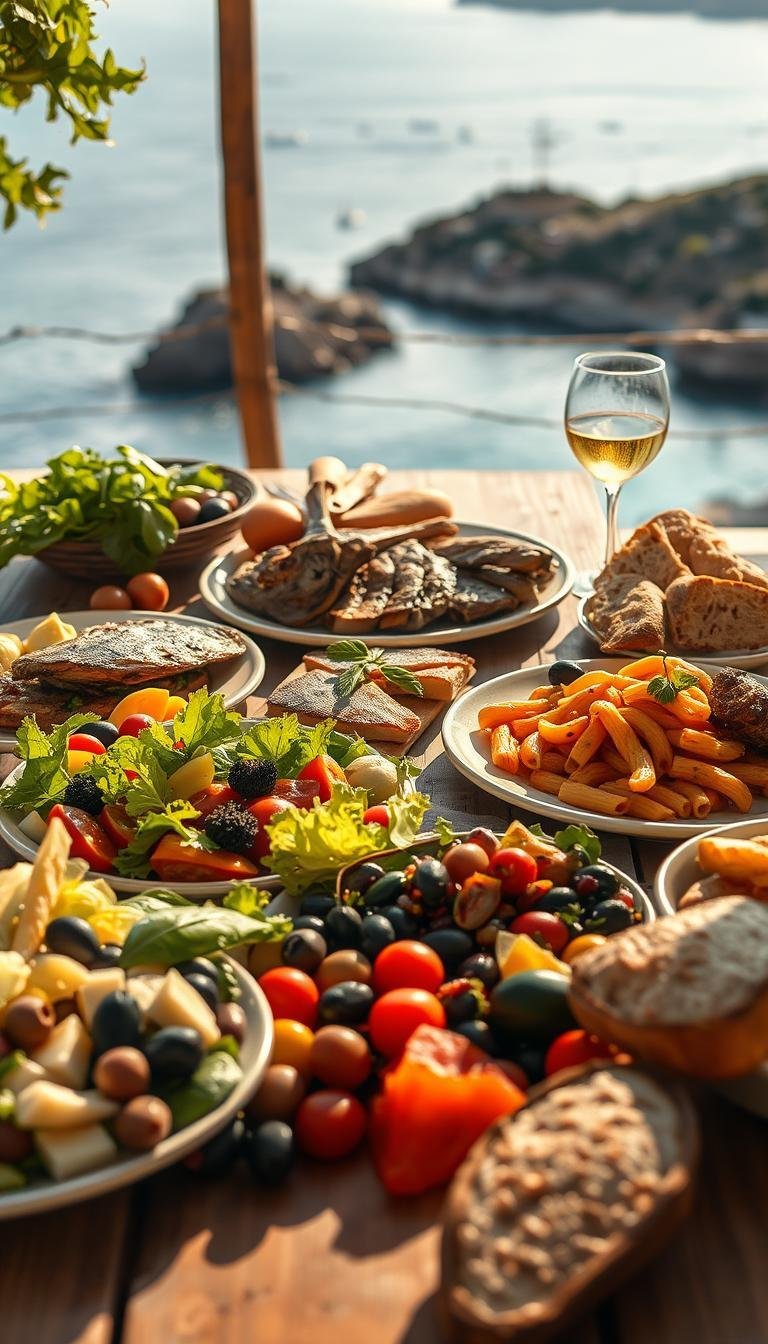(Hey! Some links in this post may be affiliate links — meaning I may earn a small commission if you buy through them, at no extra cost to you. As an Amazon Associate, I earn from qualifying purchases. I only share products I genuinely love and think you’ll find useful too. Read the full disclosure here).
Welcome to the vibrant world of Mediterranean eating! This guide shares the best Mediterranean diet guidelines. It helps you embrace this timeless lifestyle. The diet comes from the sunny cuisines of Greece, Italy, and Spain.
Health experts rank it among the healthiest diets. UNESCO even recognizes it as cultural heritage. It’s known for its health and community values.
Wondering where to start? These Mediterranean diet rules simplify the process. Whether you’re new to cooking or just want to eat healthier, this guide breaks it down. You’ll learn simple swaps, like swapping butter for olive oil, and how to pick fresh ingredients.
No complicated steps—just clear, actionable tips. Stick to these guidelines, and you’ll enjoy benefits like boosted energy and heart health. Let’s make this journey easy! This guide ensures you’ll feel confident every step of the way.
Contents
- 1 What is the Mediterranean Diet?
- 2 Core Principles of the Mediterranean Diet
- 3 The Importance of Fruits and Vegetables
- 4 Whole Grains and Legumes: Staples of the Diet
- 5 Healthy Proteins: Fish, Poultry, and Nuts
- 6 How to Incorporate Olive Oil into Your Meals
- 7 Importance of Herbs and Spices
- 8 The Mediterranean Diet and Lifestyle
- 9 Common Mistakes to Avoid on the Mediterranean Diet
What is the Mediterranean Diet?
The Mediterranean Diet is more than a trend. It’s a way of eating that has been around for centuries. It’s known for its Mediterranean Diet Benefits that help people live longer and feel better.
Overview of Its Origins
In the 1950s, scientists noticed something interesting. People in Greece, Italy, and Spain were very healthy, even with limited medical care. A
“The diet of Crete, rich in plant foods and olive oil, correlates with exceptional health outcomes.”
This finding led to many studies. They confirmed the Mediterranean Diet Benefits. Now, it’s a model for healthy living.
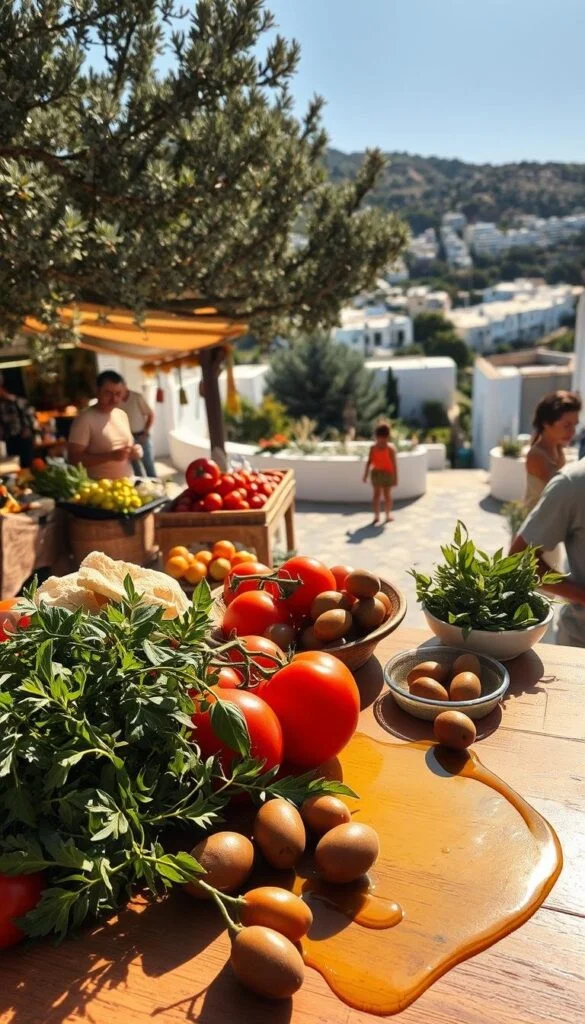
Key Components
The diet is all about eating whole, natural foods. A typical Mediterranean Diet Food List includes:
- Lots of vegetables, fruits, and whole grains
- Healthy fats like olive oil and nuts
- Fish and seafood several times weekly
- Moderate amounts of dairy and poultry
- Occasional red meat
Think of Greek salad with olive oil, Spanish paella with shrimp, or Italian bruschetta with tomatoes. These dishes show the Mediterranean Diet Food List. They mix tradition with nutrition. You can make it your own, using fresh, seasonal foods.
Core Principles of the Mediterranean Diet
The Mediterranean Diet’s success comes from its Mediterranean Diet Rules. It focuses on natural ingredients and mindful eating. This approach makes meals a journey to wellness, without strict rules.
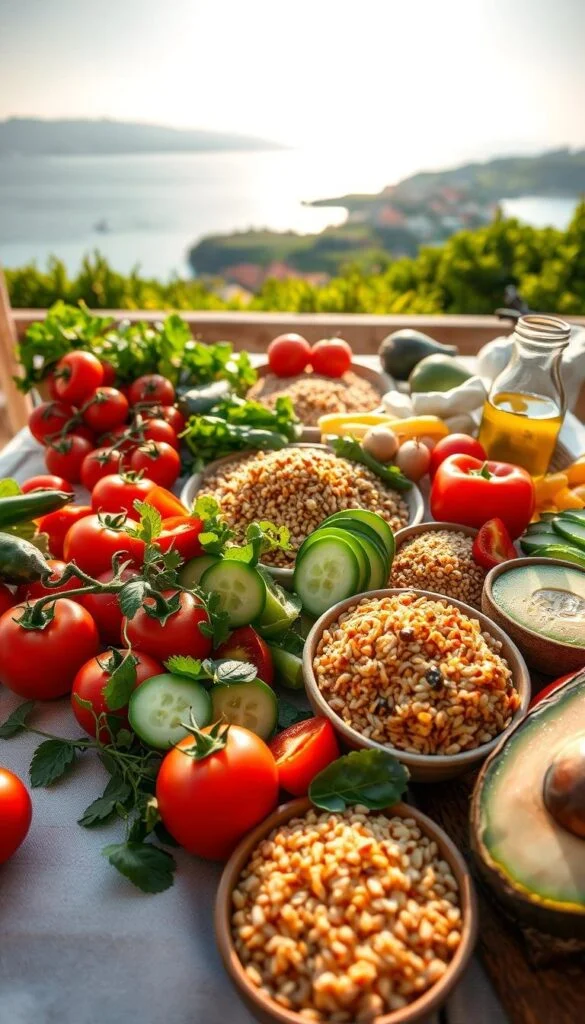
Emphasis on Whole Foods
Whole foods are key in this diet. Think fresh veggies, fruits in season, and unprocessed grains. These foods give you vitamins, fiber, and antioxidants without added stuff.
For example, choosing an apple over a candy bar or quinoa over white pasta is better.
“Whole foods aren’t just healthier—they’re more satisfying,” says Dr. Lena Torres, a nutrition specialist. “They keep you full longer and reduce cravings.”
Healthy Fats vs. Unhealthy Fats
The diet teaches the difference between good and bad fats. Healthy fats like olive oil, nuts, and fatty fish (e.g., salmon) are good for your heart. On the other hand, bad fats in fried foods or margarine can harm your health.
- Healthy Swaps: Use avocado instead of mayo, or drizzle olive oil over salads instead of creamy dressings.
- Limit: Fried snacks, butter, and packaged cookies.
Small changes like these follow the Mediterranean way. They make flavor and nutrition top priorities.
The Importance of Fruits and Vegetables
Colorful fruits and vegetables are key in the Mediterranean Diet. They give us vitamins, fiber, and antioxidants. These nutrients are vital for our health. A good rule is to fill half your plate with these foods at every meal.
“A variety of colors on your plate means a variety of nutrients in your body.” — Traditional Mediterranean culinary philosophy
Recommended Daily Servings
Try to eat foods like roasted eggplant, zucchini, or artichokes. Also, enjoy fruits like pomegranates or figs. Here’s how to get 5–10 servings a day:
- 1 small apple = 1 serving
- ½ cup cooked spinach = 1 serving
- ½ cup berries = 1 serving
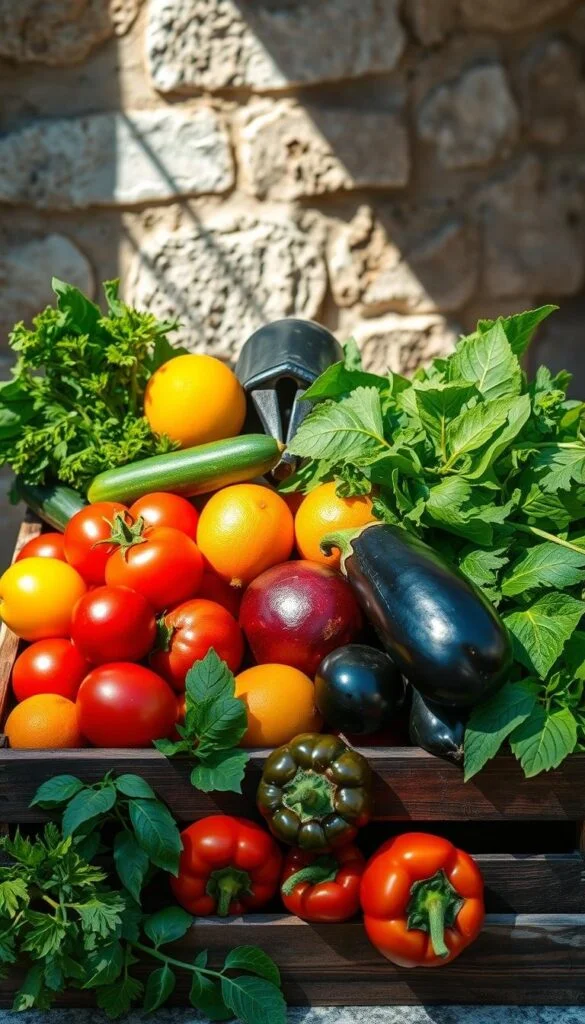
Seasonal and Local Produce
Follow nature’s calendar! Eating seasonally boosts flavor and nutrition. Here are some U.S. seasonal picks:
Spring/Summer: Asparagus, peaches, and cherry tomatoes
Fall/Winter: Butternut squash, pomegranates, and Brussels sprouts
Join a Mediterranean Diet Food List inspired by local farms. Visit farmers’ markets or CSA programs. You’ll find new favorites like kohlrabi or Romanesco broccoli. Fresh produce tastes better and supports your health.
Whole Grains and Legumes: Staples of the Diet
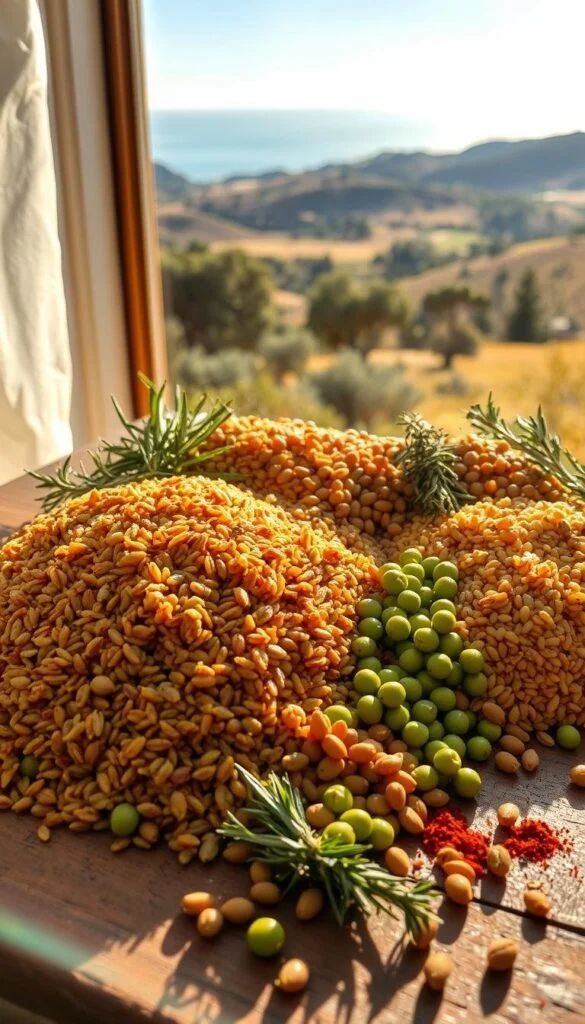
Whole grains and legumes are key in the Mediterranean Diet Food List. They give us slow energy, fiber, and plant protein. This makes meals balanced and healthy. Let’s see how to pick the best ones and enjoy their benefits.
Choosing the Right Grains
Choose unprocessed, high-fiber grains like farro, bulgur, and barley. Stay away from refined grains that don’t say “whole” on the label. Here are some ways to use them:
- Bulgur in tuna salads or veggie burgers
- Barley in soups or as a rice substitute
- Whole wheat pasta in classic spaghetti dishes
Try brown rice instead of white rice in stir-fries or bowls. It adds fiber without changing the taste.
Benefits of Legumes
Beans, lentils, and chickpeas are full of protein and minerals. They’re also good for your wallet and the planet. To make them easier to digest:
- Soak dried beans overnight before cooking.
- Add fennel seeds or bay leaves while cooking.
- Start with small portions to adapt gradually.
Pair legumes with whole grains like quinoa or couscous for a complete protein. Add chickpeas to salads or make hummus for quick Mediterranean Diet Meal Plan ideas.
Healthy Proteins: Fish, Poultry, and Nuts
Choosing the right proteins is key to Mediterranean Diet Rules. This approach swaps oversized steaks for smaller, nutrient-dense options. These options fit Mediterranean Diet Weight Loss goals. Prioritizing seafood and plant-based proteins keeps meals light yet satisfying.
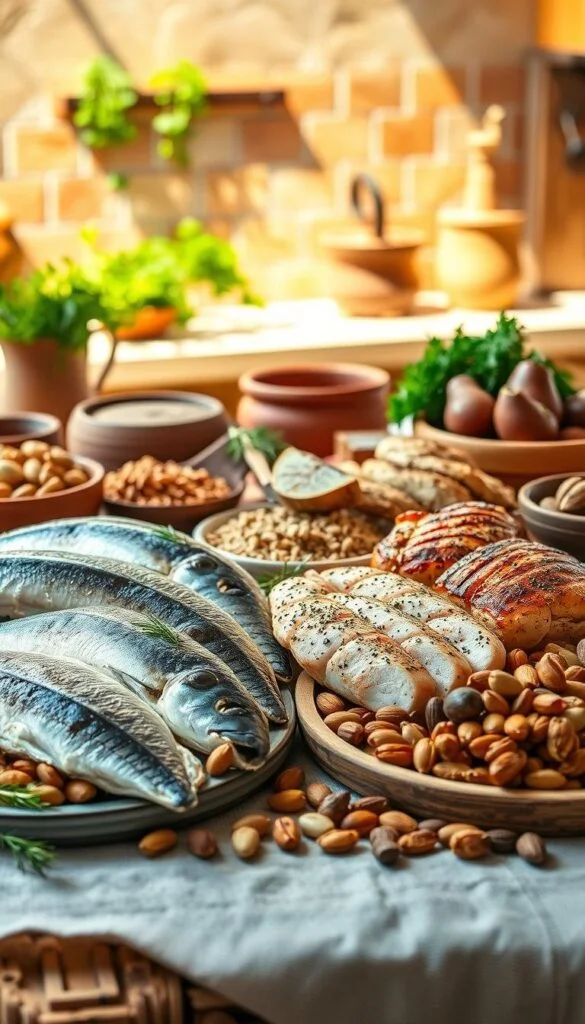
Recommended Protein Sources
Focus on these protein priorities:
- Fish & Seafood: Aim for 2-3 servings weekly of fatty fish like salmon or sardines. Their omega-3s support heart health.
- Poultry & Eggs: Skinless chicken or turkey as main proteins 2-3 times weekly. Eggs make great breakfast additions.
- Nuts & Seeds: Almonds, walnuts, and pistachios daily as snacks or toppings. Add chickpeas or lentils for extra plant-based protein.
- Red Meat: Save for special occasions—no more than a few times monthly.
“The Mediterranean approach treats meat as a flavor enhancer, not the main event.” — Mediterranean Nutrition Institute
Portion Control Tips
Visual cues simplify portion management:
- Fish/poultry: Cooked portions should fit in the palm of your hand (3-4 oz). Think of it as a side, not the main focus.
- Nuts: A small handful (1/4 cup) provides enough protein without overdoing calories.
- Meat in meals: Use ground beef or bacon as seasoning in dishes like soups or pastas, not the star.
Adapting to this style may feel unfamiliar at first. But small swaps, like swapping a steak for shrimp in stir-fry, build new habits. Over time, your plate becomes a mix of flavors. Proteins complement vegetables and grains, aiding Mediterranean Diet Weight Loss without strict restrictions.
How to Incorporate Olive Oil into Your Meals
Olive oil is key to Mediterranean Diet Tips, making it easy to eat healthier. It’s rich in history and backed by science, adding flavor and health benefits.
Health Benefits of Olive Oil
Extra virgin olive oil (EVOO) is special because of its monounsaturated fats. These fats are good for your heart. Research shows its antioxidants fight inflammation, which can lead to chronic diseases.
Registered dietitian Maria Lopez says, “EVOO’s polyphenols protect cells from damage.”
Tips for Cooking with Olive Oil
- Choose grades wisely: Use EVOO for dressings or finishing drizzles. Light olive oil is better for high-heat cooking because it has a higher smoke point.
- Experiment with flavors: Toss veggies with a light drizzle before roasting, or mix into hummus for creaminess.
- Swap butter: Dip bread in olive oil mixed with herbs instead of spreading margarine.
- Store properly: Keep bottles in a cool, dark pantry to preserve freshness.
Start small—replace one tablespoon of salad dressing daily with EVOO. Quality matters: splurge occasionally on certified EVOO for its robust taste, but budget options also offer benefits. Every swap brings you closer to Mediterranean wellness without overwhelming changes.
Importance of Herbs and Spices
Herbs and spices are key to unlocking the Mediterranean Diet’s vibrant flavors. They add depth to meals and boost nutrition. Try these Mediterranean Diet Tips to make your dishes better:
“A pinch of herbs is worth a pound of salt.” — Mediterranean culinary tradition
Flavorful Alternatives to Salt
Swap salt for these bold flavors to cut down on sodium:
- Use lemon or orange zest to brighten salads and grains
- Combine garlic, onion, and black pepper for savory depth
- Try herb blends like herbs de Provence or Italian seasoning in roasted veggies
- Add red pepper flakes for a spicy kick without sodium
Popular Herbs and Their Uses
Learn to use these Mediterranean pantry staples:
- Basil: Fresh in pesto, tomato dishes, or Caprese salads
- Oregano: Dried in Greek salads and grilled meats
- Rosemary: Fresh sprigs for roasting potatoes or lamb
- Thyme: Pairs with fish or in bean-based Mediterranean Diet Recipes
- Parsley: Use as a garnish or in tabbouleh salads
Start a small herb garden for fresh basil or mint. Store dried herbs in airtight containers, away from light. Begin by adding one new herb each week. Your taste buds will change, and you’ll love the real taste of Mediterranean cooking!
The Mediterranean Diet and Lifestyle
Adopting the Mediterranean Diet is more than just eating right. It’s a lifestyle that combines mindful eating with daily habits for better wellness. The Mediterranean Diet Benefits shine when you add physical activity and social rituals to your routine.
Importance of Physical Activity
Traditional Mediterranean lifestyles focus on natural movement over strict exercise. Think of walks after meals, gardening, or biking for errands. Here’s how to make activity a part of your day:
- Take short walks during breaks at work
- Choose stairs over elevators
- Host gatherings outdoors to encourage movement
Meal Timing and Social Eating
In Mediterranean cultures, meals are shared events. A classic Mediterranean Diet Meal Plan includes bigger lunches and lighter dinners. This helps digestion and strengthens family bonds. Studies show eating with others reduces stress and helps with healthier portions.
“Social meals strengthen community ties and contribute to longevity.”
For busy Americans, small changes can help. Try scheduling one weekly family dinner or planning weekend cooking sessions. Even brief shared meals can create strong bonds.
Small steps, like a post-dinner stroll or cooking together, help you embrace this holistic approach. Every change brings you closer to the Mediterranean way of living well.
Common Mistakes to Avoid on the Mediterranean Diet
To get the most out of the Mediterranean Diet, avoid certain habits. These can lessen its health benefits. Even those trying for Mediterranean Diet Weight Loss might fall into these traps.
Overprocessed Foods
Stay away from processed foods like store-bought dressings or hummus. They often have additives. Choose fresh ingredients instead. Look for hidden sugars or sodium in labels.
Making your own hummus with chickpeas, tahini, and lemon is easy. It’s a great Mediterranean Diet Recipe. Eating whole foods is key to following the Best Mediterranean Diet Guidelines for lasting results.
Ignoring Portion Sizes
Even healthy foods like olive oil or nuts can lead to too many calories if eaten too much. Use a drizzle of oil and a small handful of nuts. This follows traditional portion sizes.
Slow down and eat mindfully. Mediterranean cultures do this by sharing meals. It helps avoid eating too much without thinking.
It’s all about progress, not being perfect. Small changes, like making your own sauces or using smaller plates, help. These steps keep you on the path to Mediterranean Diet Weight Loss or better health. Every step towards these Best Mediterranean Diet Guidelines brings benefits.


